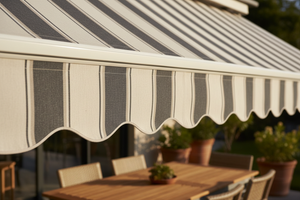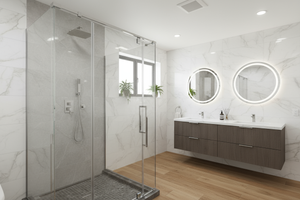Sliding Gate Motor & Swing Gate Motor: The Definitive Guide to Automation

Introduction: Embracing the Future of Gate Access
In today’s world, where efficiency and security are paramount, the traditional manual gate is quickly becoming a thing of the past. Think about the inconvenience of stopping your car, stepping out in bad weather, and struggling to open a heavy gate by hand. Thanks to modern technology, this hassle is now easily eliminated. Gate automation has evolved from a luxury reserved for grand estates into an accessible and practical solution for both residential and industrial properties. It offers a seamless combination of convenience, enhanced security, and increased property value. The growing market for gate automation reflects a widespread shift toward smarter, safer access control.
Automating your gate means more than just avoiding the daily inconvenience; it transforms the perimeter of your property into a secure, controlled entry point. Automated gates deter intruders, ensure your property remains safely enclosed, and provide peace of mind for homeowners and business operators alike. This definitive guide will explore the world of gate automation in depth. We will explain the key differences between sliding gate motors and swing gate motors, helping you understand which system is the most suitable solution for your needs. Additionally, we will discuss important factors such as gate weight, power options, and essential accessories that make a modern gate automation system safe, reliable, and high-performing.
Understanding Gate Automation: The Basics
Gate automation is much more than simply attaching a motor to a gate. It is an integrated system designed to provide reliable, secure, and convenient operation every time you enter or leave your property.
Defining Gate Automation Systems
At its core, a gate automation system consists of an electromechanical motor fitted with a control unit. This motor physically moves the gate open or closed, while the control unit serves as the system’s brain, receiving commands from access devices such as remotes, keypads, or smartphone apps. Together, these components allow you to automate your gates, eliminating the need for manual operation.
Key Benefits: Security, Convenience, and Property Value
The primary advantages of installing gate motors are enhanced security, improved convenience, and increased property value. Automated gates create a controlled entry point that deters unauthorized access and provides a strong first line of defense. Convenience is a daily benefit, freeing you from the need to manually open and close your gates, especially in poor weather. Furthermore, installing an automated gate system is a significant upgrade that boosts your property’s curb appeal and overall market value.
Core Components of an Automatic Gate System
Every automatic gate system relies on two main components: the motor and the control unit. The motor provides the power needed to move the gate, while the control unit processes signals from your access device—such as a remote control—and directs the motor accordingly. The control unit also manages safety features like photocells and integrates additional accessories that enhance security and performance.
Sliding Gate Motors: Powering Horizontal Movement
Sliding gates are an increasingly popular choice, especially for properties where space is limited or where the driveway has a steep incline. A sliding gate motor is the ready-to-install engine that drives this efficient, space-saving design. The motor's gear, known as a pinion, engages with a toothed rack attached to the gate, allowing the motor to move the gate smoothly along its track.
How Sliding Gates Work
Sliding gates operate by moving horizontally along a track fitted to the fence line. The sliding gate motor engages with a toothed rack attached to the gate. When activated, the motor’s gear, known as a pinion, turns and pulls the rack, sliding the gate open or closed smoothly. This robust and straightforward mechanism is suitable for a wide range of gate sizes and weights, making it a versatile solution for many residential and commercial settings.
Types and Considerations for Sliding Gate Motors
Sliding gate motors come in various types based on power source and capacity. For residential use, motors are designed to handle lighter gates and less frequent operation, while heavy-duty industrial motors are built for larger gates and continuous use. When selecting a sliding gate motor, consider the following factors:
-
Gate Weight: The motor must be rated to handle the full weight of the gate for reliable performance.
-
Gate Length: This determines the length of the rack and the space required for the gate to slide fully open.
-
Duty Cycle: This refers to how often the gate is operated; commercial sites typically require motors with higher duty cycles for frequent use.
Choosing the right sliding gate motor ensures smooth operation, high reliability, and long-lasting performance.
Swing Gate Motors: Automating Pivoting Entry
Swing gates provide a classic and elegant entrance, opening by pivoting either inward or outward like a traditional door. Automating swing gates requires motors specifically designed to replicate this swinging motion safely and efficiently.
How Swing Gates Work
Swing gates can be single-leaf or double-leaf, and their automation relies on motors equipped with articulated arms or linear actuators. An articulated arm motor features a hinged arm that mimics the motion of a human arm, making it ideal for gates with wide pillars. Alternatively, linear actuators—also known as rams—use a piston-style mechanism to push and pull the gate, offering a sleek and discreet design.
Another option includes underground motors, which are installed below the gate’s pivot point. These motors preserve the gate’s aesthetic appeal by remaining hidden while providing reliable automation.
Types and Considerations for Swing Gate Motors
When choosing a swing gate motor, consider the following:
-
Gate Design: Solid gates face higher wind loads, requiring motors with sufficient power to operate smoothly.
-
Opening Angle: Most swing gates open between 90 and 120 degrees, and the motor must accommodate this range.
-
Wind Load: The motor must be capable of overcoming wind resistance to ensure consistent operation.
Properly selecting a swing gate motor will ensure safe, smooth, and reliable automation for your property’s entrance. For example, a popular option is the 1200kg 20W Solar Double Swing Auto Motor with Remote Gate Opener, which combines solar power efficiency with robust performance.
Choosing the Right Gate Motor
Selecting the perfect gate motor involves careful evaluation of your specific needs and property conditions.
Assess Your Gate
Begin by identifying your gate type—sliding or swing—along with its weight and how frequently it will be used. Heavy gates that see frequent operation demand more robust motors to maintain performance and longevity.
Power Source Options
Most gate motors operate on mains AC power, which is reliable and widely available, making it the standard choice for many residential and commercial installations. This power source ensures consistent and uninterrupted operation, especially in urban and suburban areas where electricity supply is stable. However, for properties located in remote or off-grid locations, where access to mains electricity may be limited or unreliable, solar-powered gate motors have become an increasingly popular alternative. These solar systems harness energy from the sun using photovoltaic panels, converting sunlight into electricity to power the gate motor.
Solar-powered gate motors typically include integrated battery backups that store excess energy generated during the day. This stored energy allows the gate to operate smoothly during nighttime or overcast conditions, ensuring continuous functionality regardless of weather fluctuations. The use of solar power not only reduces dependency on the electrical grid but also offers an environmentally friendly and cost-effective solution by lowering electricity bills and minimizing carbon footprint.
Moreover, advancements in solar technology and battery efficiency have significantly improved the performance and reliability of solar-powered gate motors. Modern systems are designed to withstand various weather conditions and include smart charging controllers that optimize battery health and longevity. These features make solar-powered gate motors a suitable and sustainable choice for a wide range of applications, from rural homes and farms to commercial properties seeking green energy solutions.
In summary, while mains AC power remains the most common and dependable source for gate motor operation, solar-powered alternatives provide a versatile and eco-conscious option, especially beneficial in locations where traditional power sources are impractical or unavailable. Choosing between these power options depends on your property's specific needs, location, and sustainability goals.
Motor Technology and Durability
Modern motors often utilize brushless DC technology, which offers improved efficiency, precision, and longer lifespan compared to traditional brushed motors. Look for motors fitted with high-quality gearing and weather-resistant casings rated at least IP54, made from durable materials like galvanized steel or aluminum to withstand outdoor conditions.
Noise and Aesthetics
Many contemporary gate motors operate silently, preserving the tranquility of your property. They also come in sleek, unobtrusive designs that complement your gate and enhance your property’s appearance. Modern advancements in motor technology have enabled manufacturers to produce quieter, more efficient motors that reduce noise pollution, making them ideal for residential areas where peace and quiet are valued. These motors often feature smooth start and stop functions, which minimize mechanical stress and contribute to a longer lifespan. Additionally, the compact and aesthetically pleasing housings are designed to blend seamlessly with various gate styles, ensuring that the automation system does not detract from your property’s curb appeal. Whether you have a traditional wrought iron gate or a contemporary aluminum design, there are motor options tailored to fit both the functional and visual requirements of your entrance. This combination of silent operation and attractive design makes modern gate motors a smart and stylish choice for enhancing security and convenience without compromising on elegance.
Essential Accessories and Advanced Features
To maximize safety, convenience, and control, gate automation systems can be fitted with a variety of accessories.
Safety Features
Photocells are a critical safety component, fitted across the gate opening to detect obstacles. If the gate encounters an obstruction, the photocells signal the control unit to stop and reverse the gate’s movement, preventing accidents and damage. Additional safety edges fitted to the gate provide further protection by halting operation upon contact.
Remote Control and Smart Connectivity
While traditional remote controls remain popular, many modern gate motors offer advanced connectivity options. Smartphone apps allow you to control your gate remotely, receive notifications about gate status, and even integrate with voice assistants for hands-free operation.
Advanced Control Units
Some control units feature technologies like D-Track torque control, which dynamically adjusts the motor’s force based on resistance. This protects the system from damage, improves safety, and extends the motor’s lifespan.
Ancillaries and Accessories
Additional accessories such as keypads, intercom systems, flashing warning lights, and loop detectors can enhance functionality, security, and user convenience. Keypads provide secure access by requiring a PIN code, making it easy for authorized users to enter without needing a remote control. Intercom systems enable clear communication between visitors and property owners before granting access, adding an extra layer of security. Flashing warning lights alert pedestrians and vehicles when the gate is in operation, improving safety by preventing accidents. Loop detectors are installed underground to sense the presence of vehicles, ensuring the gate only operates when a vehicle is detected, which helps prevent gate closure on cars or other obstacles. Together, these accessories create a comprehensive automation system that not only improves ease of use but also significantly boosts the overall safety and security of your property’s entrance.
Installation, Maintenance, and Troubleshooting
Professional Installation Recommended
Though some gate motor kits are marketed for DIY installation, professional installation is highly recommended. Expert installers ensure that your system is set up safely, complies with local regulations, and performs optimally.
Routine Maintenance
To maintain reliability and performance, regularly clean gate tracks and hinges, test safety devices like photocells, and schedule annual check-ups. Proper maintenance extends the life of your gate motors and reduces the risk of unexpected failures.
Conclusion
Choosing between a sliding gate motor and a swing gate motor depends largely on your property’s layout, gate design, and usage requirements. Understanding the components, safety features, and installation needs of each system will help you select a ready, fitted solution that enhances your property’s security, convenience, and value. Gate automation is not just a modern convenience—it is the future of secure and efficient gate access. Investing wisely in a high-quality gate motor system ensures lasting benefits for years to come.
For a wide selection of gate automation solutions, visit our gate openers collection.
Frequently Asked Questions (FAQ)
What is the difference between a sliding gate motor and a swing gate motor?
Sliding gate motors move gates horizontally along a track, making them ideal for properties with limited space. Swing gate motors pivot gates open like doors, suitable for properties with ample driveway clearance.
Can I automate any type of gate?
Most gates can be automated with the appropriate motor and accessories. Factors such as gate weight, size, and design influence the choice of motor and automation system.
How important are safety features like photocells?
Safety features are essential to prevent accidents and damage. Photocells detect obstacles and stop or reverse gate movement, ensuring safe operation.
Are solar-powered gate motors reliable?
Yes, solar-powered motors are reliable, especially when equipped with battery backups. They are an excellent option for remote locations without easy access to mains power.
Can I control my gate automation system with a smartphone?
Many modern systems offer smart connectivity, allowing remote control via apps, notifications, and integration with voice assistants.
How often should I maintain my gate motor?
Regular maintenance, including cleaning tracks and testing safety devices, should be performed annually or as recommended by the manufacturer to ensure longevity and optimal performance.
Is professional installation necessary?
Professional installation is highly recommended to guarantee safety, proper setup, and compliance with regulations, although some DIY kits are available for experienced users.
 1300 760 441
1300 760 441 cs@factoryfast.com.au
cs@factoryfast.com.au Tags:
Tags:






















